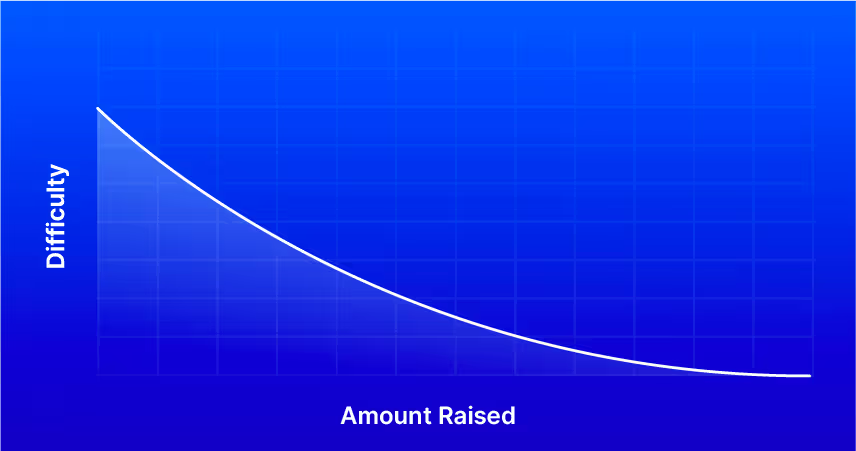The Secret to Fundraising: What all great founders do but don't share.

.avif)
If you've ever tried to raise startup capital from venture capitalist or angel investors, you'll know how difficult raising capital really is. But what if I told you it doesn’t have to be difficult? In fact, you’re probably making it a lot harder than it needs to be.
Well, in this article I will be sharing a tactic that the most talented startup founders use when raising capital.
Let's teach you how it works!
Understanding How Investors Think
Before we can explain this tactic, we first have to cover why it's necessary.
For starters, when you're raising capital you're often meeting with venture capitalists and although some venture capitalists are trailblazers, the vast majority are followers.
This means they are extremely unlikely to invest unless there are other investors already committed to your round.
If you are able to lock in an initial investor, this is seen as a strong signal and drastically increases the odds that others will invest too.
So the question you should be asking yourself is…
How can I get the first investor in the door?
After all, if you can solve this, the rest of your round becomes a whole lot easier.
Now, let’s run through the tactic that the most talented fundraisers use to lock in their first investor.
The Secret to Fundraising
When you really get down to it, the process isn't all that complicated. Think about it for a moment, what would make an investor more likely to invest in your round?
The answer is simple when you really push the boundaries. How about an extremely low valuation. This would likely be seen as an amazing deal from their perspective. That would get them interested wouldn't it?
And I’m going to reiterate, if you're able to successfully lock in your first investor, you're now on your way to a successful fundraise because it will make all future conversations with investors 10 times easier.
There are some caveats you should be aware of though. You might even be asking “Won’t that lead to a ton of dilution?” And you're right, it would. But only if you raised the entire round at that low valuation you’d own very little of the company.
So how can you avoid dilution but still get the benefits of that first investor?
The Staggered Fundraising Round

To avoid a lot of dilution, don’t raise the entire round at a low valuation. As soon as you’ve locked in your first and earliest investor, it's totally fine and even common for founders to increase the valuation of that same round.
To put it simply, keep your valuation low when you start and increase it as you lock in more investors. This is common and if investors ask about it, you can be upfront by saying something along the lines of “Yes, the terms are slightly more favorable for our earliest investors who took on the biggest risk.” Most investors won’t push back on it.
Important note: This doesn't apply to priced rounds where the price is set, but it's perfect for seed rounds or for convertible notes where you can make adjustments to the fundraise depending on the stage of the fundraise.
The Snowball Effect

One of the biggest benefits of this is the snowball effect that will take place as your round progresses. The more investors and funds committed, the easier it will be to raise additional capital.
This happens because Instead of approaching investors with a $1mm raise and no commitments, you’ll be able to approach them with a $1mm raise and 50% of the round already committed. If you raise that $1mm, you'll then be able to expand the raise to $1.5mm with 75% of the round already committed.
Hopefully, you’re starting to see how this can quickly snowball into a multi million dollar raise.
And this approach is super common. Lots of startups raise more than they initially anticipated, expanding the round when there is more interest than the round has room for.
Setting Your Valuation
This is helpful but you might be wondering where you should start. And this really depends on your traction, team, and founder backgrounds.
Even still, it’s better to start low so you can get your first investor in the door so later conversations are easy. You want to avoid a long drawn out raise and having no initial investor is a sure fire way to do this.
So where should you start?
For most teams, somewhere between a $5mm and $10mm valuation cap is going to be perfect. If you have no product or little to no traction, lean more on the $5mm side of that range.
Once you’ve raised $250k to $500k, expand the raise and increase the valuation.
If you’re looking for some guidance on what you should aim for, check out our article on setting a valuation.
Wrapping Up
At the end of the day, raising capital for a startup is HARD so it’s in your interest to make it as easy as possible. Just be sure to calculate the dilution of your plan before getting started. Lots of founders are shocked at the dilution that takes place when convertible notes convert into stock so do your research.
If you’re looking for a way to map out this raise, I like Cake Equity’s Dilution Calculator but you can also use LeadLoft’s cap table resource and adjust the table to see what makes sense for your team.
We also wrote this blog based on my own experience and with a combination of insights from Ryan Breslow’s book Fundraising and listening to Jason Calacanis. If you found this article helpful, go follow and support them too.
Lastly, if you’re raising capital, feel free to reach out to our team. We help hundreds of founders get in touch with investors every year and would love to help you too.






